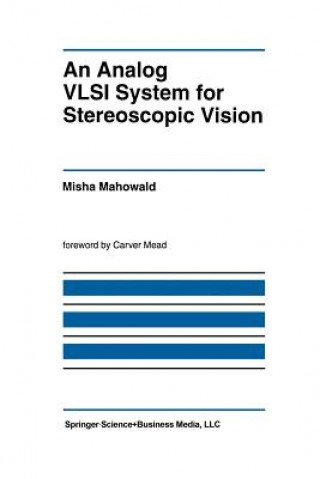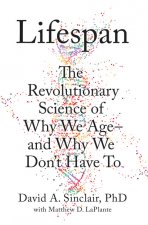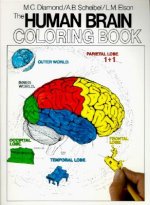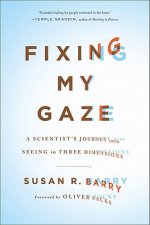
Kód: 02076572
Analog VLSI System for Stereoscopic Vision
Autor Misha Mahowald
An Analog VLSI System for Stereoscopic Vision investigates the interaction of the physical medium and the computation in both biological and analog VLSI systems by synthesizing a functional neuromorphic system in silicon. §In both ... celý popis
- Jazyk:
 Angličtina
Angličtina - Väzba: Brožovaná
- Počet strán: 215
Nakladateľ: Springer-Verlag New York Inc., 2012
- Viac informácií o knihe

139.54 €

Skladom u dodávateľa v malom množstve
Odosielame za 12 - 15 dní
Potrebujete viac kusov?Ak máte záujem o viac kusov, preverte, prosím, najprv dostupnosť titulu na našej zákazníckej podpore.
Pridať medzi želanie
Mohlo by sa vám tiež páčiť
-

Concepts in Surface Physics
314.63 € -

Dim Mak Deadly Nerve Points
56.92 € -21 % -

Hemoglobin and Its Diseases
180.09 € -

Nový přehled biologie
52.31 € -15 % -

Nucený výsek
9.10 € -5 % -

vie litteraire Premiere serie
54.66 € -

Hetaerenbriefe
29.17 €
Darčekový poukaz: Radosť zaručená
- Darujte poukaz v ľubovoľnej hodnote, a my sa postaráme o zvyšok.
- Poukaz sa vzťahuje na všetky produkty v našej ponuke.
- Elektronický poukaz si vytlačíte z e-mailu a môžete ho ihneď darovať.
- Platnosť poukazu je 12 mesiacov od dátumu vystavenia.
Viac informácií o knihe Analog VLSI System for Stereoscopic Vision
Nákupom získate 345 bodov
 Anotácia knihy
Anotácia knihy
An Analog VLSI System for Stereoscopic Vision investigates the interaction of the physical medium and the computation in both biological and analog VLSI systems by synthesizing a functional neuromorphic system in silicon. §In both the synthesis and analysis of the system, a point of view from within the system is adopted rather than that of an omniscient designer drawing a blueprint. This perspective projects the design and the designer into a living landscape. The motivation for a machine-centered perspective is explained in the first chapter. The second chapter describes the evolution of the silicon retina. The retina accurately encodes visual information over orders of magnitude of ambient illumination, using mismatched components that are calibrated as part of the encoding process. The visual abstraction created by the retina is suitable for transmission through a limited bandwidth channel. The third chapter introduces a general method for interchip communication, the address-event representation, which is used for transmission of retinal data. The address-event representation takes advantage of the speed of CMOS relative to biological neurons to preserve the information of biological action potentials using digital circuitry in place of axons. The fourth chapter describes a collective circuit that computes stereodisparity. In this circuit, the processing that corrects for imperfections in the hardware compensates for inherent ambiguity in the environment. The fifth chapter demonstrates a primitive working stereovision system. §An Analog VLSI System for Stereoscopic Vision contributes to both computer engineering and neuroscience at a concrete level. Through the construction of a working analog of biological vision subsystems, new circuits for building brain-style analog computers have been developed. Specific neuropysiological and psychophysical results in terms of underlying electronic mechanisms are explained. These examples demonstrate the utility of using biological principles for building brain-style computers and the significance of building brain-style computers for understanding the nervous system. §
 Parametre knihy
Parametre knihy
Zaradenie knihy Knihy po anglicky Mathematics & science Biology, life sciences Life sciences: general issues
139.54 €
- Celý názov: Analog VLSI System for Stereoscopic Vision
- Autor: Misha Mahowald
- Jazyk:
 Angličtina
Angličtina - Väzba: Brožovaná
- Počet strán: 215
- EAN: 9781461361749
- ISBN: 1461361745
- ID: 02076572
- Nakladateľ: Springer-Verlag New York Inc.
- Hmotnosť: 367 g
- Rozmery: 235 × 155 × 13 mm
- Dátum vydania: 08. October 2012
Obľúbené z iného súdka
-

The Molecule of More
16.47 € -23 % -

Evolution
28.86 € -8 % -

Power, Sex, Suicide
13.10 € -18 % -

Psychopath Inside
16.88 € -13 % -

Murderous Minds
16.37 € -6 % -

Science of Meditation
11.05 € -23 % -

Oxygen
12.28 € -23 % -

Race Differences in Intelligence
35.83 € -

Equine Genomics
229.75 € -

The Selfish Gene
11.66 € -19 % -

Undoing Project
11.05 € -15 % -

Biology of Belief
17.70 € -23 % -

Power of Habit
12.07 € -24 % -

Sapiens
21.49 € -

Lifespan
24.15 € -23 % -

The Extended Phenotype
13.30 € -23 % -

Into the Magic Shop
15.04 € -22 % -

Homo Deus
11.35 € -21 % -

Cosmic Serpent
10.43 € -28 % -

Greatest Show on Earth
11.25 € -22 % -

Speculations on the Evolution of Human Intelligence
9.72 € -7 % -

Blind Watchmaker
12.89 € -24 % -

We Are Our Brains
11.46 € -21 % -

River Out of Eden
11.15 € -23 % -

Brain Book
23.54 € -17 % -

Human Brain Coloring Book
17.40 € -28 % -

Crack In Creation
17.50 € -5 % -

Schaum's Outline of Genetics, Fifth Edition
29.07 € -14 % -

Brain Rules (Updated and Expanded)
16.58 € -3 % -

Hidden History of the Human Race
13.91 € -19 % -

Fixing My Gaze
22.41 € -

Neanderthal Man
15.45 € -20 % -

Why We Run
16.78 € -13 % -

On Natural Selection
9.82 € -

Handbook of Spine Surgery
133.50 € -

Cartoon Guide to Genetics
16.58 € -23 % -

Ecological Thought
26.41 € -6 % -

Creative Evolution
18.42 € -4 % -

Brief History of Everyone Who Ever Lived
10.95 € -24 % -

Consciousness
15.96 € -17 % -

Social Conquest of Earth
16.99 € -11 % -

Atlas of Human Brain Connections
143.02 € -

Double Helix
17.91 € -8 % -

Masters of the Planet
16.17 € -21 % -

Vital Dust
32.45 € -

What Mad Pursuit
29.37 € -

Zooarchaeology and Modern Human Origins
121.63 € -

Handbook of Schizophrenia Spectrum Disorders, Volume I
214.59 € -

Tree of Life
49.55 € -3 %
Osobný odber Bratislava a 2642 dalších
Copyright ©2008-24 najlacnejsie-knihy.sk Všetky práva vyhradenéSúkromieCookies


 19 miliónov titulov
19 miliónov titulov Vrátenie do mesiaca
Vrátenie do mesiaca 02/210 210 99 (8-15.30h)
02/210 210 99 (8-15.30h)